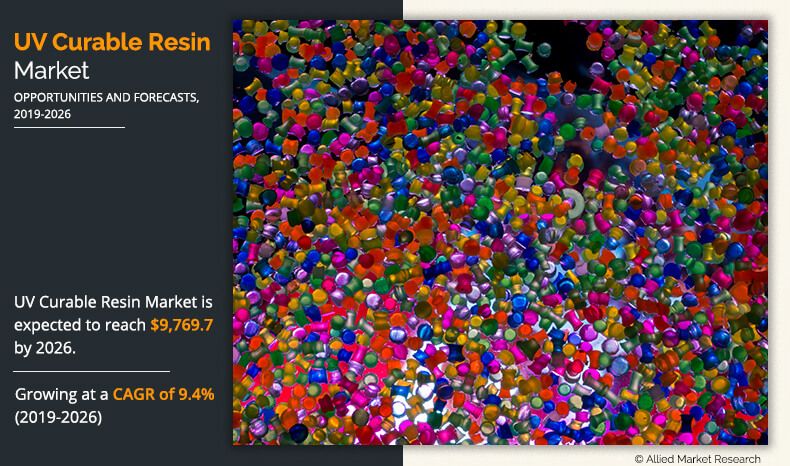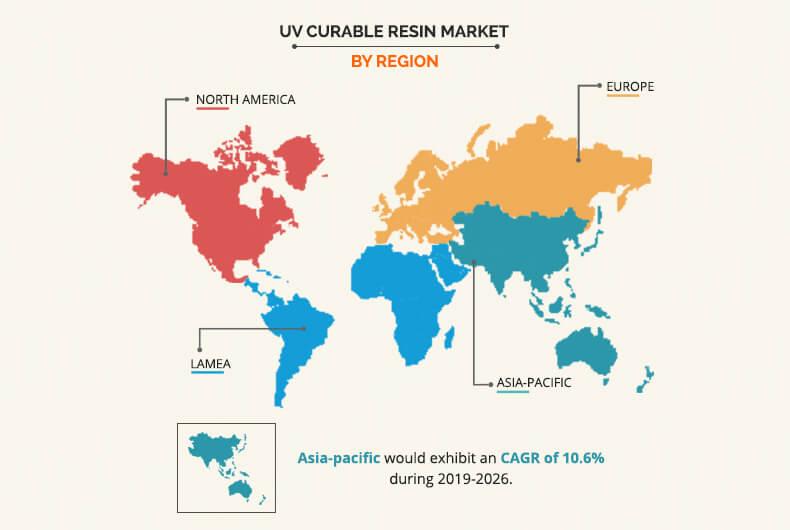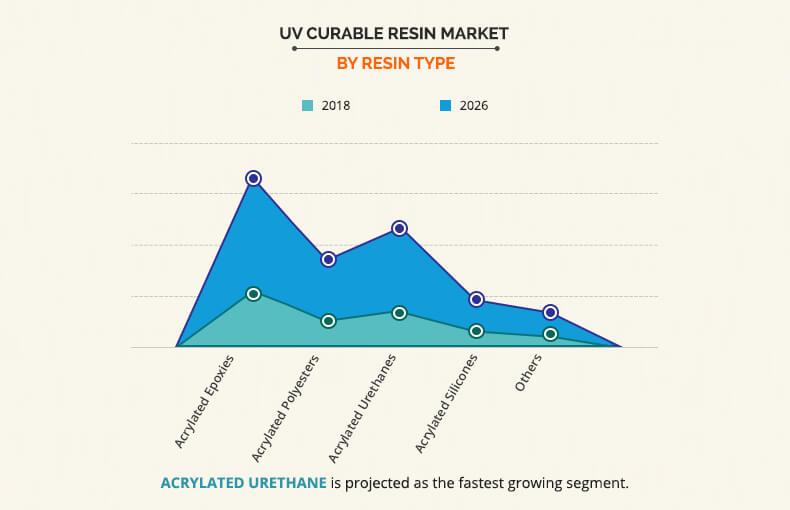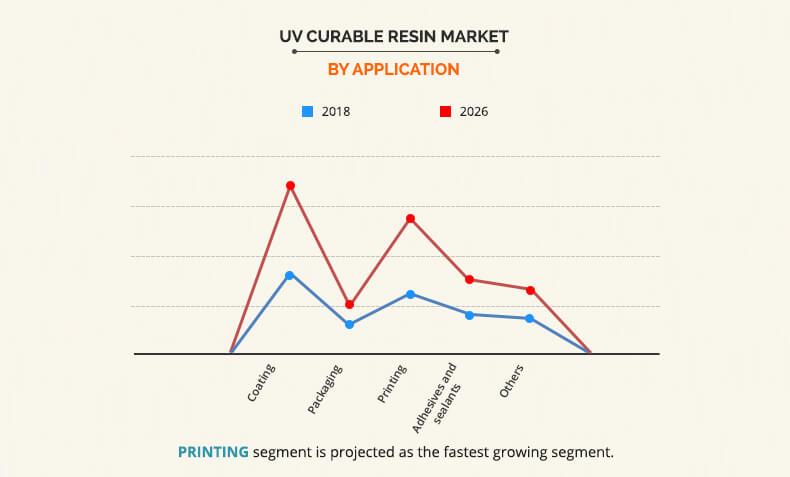UV Curable Resin Market Outlook - 2026
The global UV curable resin market size was valued at $4.7 billion in 2018 and is estimated to reach $9.8 billion by 2026, growing at a CAGR of 9.4% from 2019 to 2026. UV-curable resin is a material polymerized and cured through energy radiated from ultraviolet devices. These resins are used as raw materials in sealing, bonding, and coating. They find their major application in manufacturing coatings, as they offer enhanced chemical resistance and fast curing time. For instance, UV curing aids in the formulation of solvent-free lacquer coatings, owing to implementation of stringent government regulations toward emission of volatile organic compounds (VOCs).
Increase in use of environment-friendly industrial coatings is one of the major drivers of the global UV curable resins market. In addition, surge in demand for UV curable inks in packaging application is expected to escalate the growth of the market. Other key factors driving the demand of the global UV curable resin market include rise in demand for green & environment-friendly paint and coating and increase in demand for architectural coatings. The paint and coating industries have developed numerous chemicals for enhancing product color, shelf life, texture, and other properties. These paints and coatings chemicals contain VOCs that vaporize as soon as they are exposed to the atmosphere. Some VOCs cause harm to human health as well as the environment. Harmful VOCs result in long-term health effects such as nose, eyes, and throat irritation, loss of coordination, damage to the liver, kidney, and even cause cancer in humans.
Moreover, paints and coating materials are also composed of heavy metals such as lead and chromium, arsenic, glycol ethers, and ethyl acetate that act as solvents for conventional paints. These solvents are harmful to inhale and are toxic to humans. The odors released from thesepaints are suffocating and cause mild irritation and major burning sensation. The long-term effects include kidney damage, liver damage, respiratory issues, and even cancer. The potential health effects of these paints have led to reconsider composition of products. This results in growth in demand for green and environment-friendly resins so that serious health and environment issues can be reduced. This in turn boost the demand for UV curable resins that are eco-friendly with excellent chemical resistance and fast curing times. However, the limited light penetration depth of UV curable resins is expected to hamper the market growth.
The light penetration depth depends on the wavelength and spectral distribution, and in case of UV curable resins, it usually does not exceed a few millimeters. Hence, application of UV curable resins is limited to inks, coatings, and adhesives, thus restraining the market growth. On the contrary, the global UV curable resins market is yet to explore its full potential. Increase in application of UV-curable resins in 3D printing, barrier films, digital printing, packaging, and printed circuit is expected to offer lucrative growth opportunities to the market.
In addition, increase in implementation of stringent environmental regulations across the globe makes it difficult for the companies with international presence to oblige with these regulations. Meeting these regulations can be a costly endeavor as norms and rules vary as per the country. To meet thesechallenges, resins companies are frequently launching eco-minded products. WATERSOL WQS-364, a UV-curable water-based polymer for water-reducible coatings on plastics is also developed for chemical and solvent resistance. Furthermore, stringent environmental regulations drive the development of low VOC additives and humectants. Thereby, offeringfuture growth opportunities to the global UV curable resins market. Several eco-based products are developed to stay compliant with regulation imposed by government of countries.
Segment Overview
The UV curable resin market is segmented based on resin type, application, and region. On the basis of resin type, the global UV curable resin market is categorized into acrylated epoxies acrylated polyesters, acrylated urethanes, acrylated silicones, and others. The applications covered in the study include coating, packaging, printing, adhesives & sealants, and others. Region wise, the market is analyzed across North America, Europe, Asia-Pacific, and LAMEA. Asia-Pacific holds more than 30% of UV curable resin market share.
UV Curable Resin Market, By Region
By region, dominated the global UV curable resin market and accounted over 30% shar in the global market owing to the growth in paints and coating industry which is the primary consumer of UV curable resins and are further expected to remain the key contributor of revenue generation in the region. The automotive industry is also consuming UV curable resins in automotive part for finishes and is predicted to contribute to the growth of the market.
By region, Asia-Pacific dominates the market owing to the growth in paints and coating industry which is the primary consumer of UV curable resins and are further expected to remain the key contributor of revenue generation in the region. The automotive industry is also consuming UV curable resins in automotive part for finishes and is predicted to contribute to the growth of the market.
UV Curable Resin Market, By Resin Type
By resin type, acrylated epoxies dominates the global UV curable resin market. These are very popular UV curing resins that endure fast radical induced cross-linking while exposed to UV radiation. These types of UV curable resins are used massively in lithographic inks and varnishes, printed circuit board, plastic coatings, wood, and concrete. One of the most common acrylated and methacrylated epoxy oligomers is based on diglycidyl ether of bisphenol A (DGEBA) and derivatives of it. In addition, acrylated epoxies have fast cure rates and good adhesion performance attributed to the presence of polar hydroxyl and ether groups in the epoxy backbone structure. This is the reason, acrylated epoxies are increasingly use in paints and varnishes.
On the other hand, acrylated urethanes is expected to be the fastest growing segment. The reason is that UV curable acrylated urethanes have good all-around performance properties on several substrates. These type of resins have good or excellent film hardness, elasticity and cure speed depending on the prepolymer used. They are widely used in resilient floor coatings and as coatings for flexible packaging because of their superior durability and flexibility.
By resin type, Acrylated Epoxies dominates the global UV curable resin market. Acrylated epoxies have fast cure rates and good adhesion performance attributed to the presence of polar hydroxyl and ether groups in the epoxy backbone structure. This is the reason, acrylated epoxies are increasingly use in paints and varnishes. Additionally, they have outstanding corrosion resistance.
Acrylated Urethanes is expected to be the fastest growing segment. The reason is that UV curable acrylated urethanes have good all-around performance properties on several substrates. These type of resins have good or excellent film hardness, elasticity and cure speed depending on the prepolymer used. They are widely used in resilient floor coatings and as coatings for flexible packaging because of their superior durability and flexibility.
UV Curable Resin Market, By Application
By application, coating segment dominates in the global UV curable resin market size of UV curable resin market. Demand for zero VOC content in coating is increasing demand for UV curable resins. The increasing use of UV curable resins in dispersants & wetting, powder coating additives, driers, defoamers, dearators and flow & leveling is driving growth of the market. The printing application segment is expected to be the fastest growing segment attributed to growing use of newer printing technologies like inkjet that are using UV curable technology to achieve technical advantages. The introduction of UV into these newer applications ensures that UV curing technology is the technology for the future.
The Printing is expected to be the fastest growing segment attributed to growing use of newer printing technologies like inkjet that are using UV curable technology to achieve technical advantages. The introduction of UV into these newer applications ensures that UV curing technology is the technology for the future.
Competitive Analysis
The key players operating in the UV curable resin market are Hitachi Chemical, BASF SE, DSM-AGI, Arkema Group, Allnex Belgium S.A., Jiangsu Litian Technology Co. Ltd., Eternal Materials, Dymax Corporation, Jiangsu Sanmu Group Co. Ltd., Toagosei Co. Ltd. To stay competitive in the industry, these market players are adopting different strategies such as product launch, acquisition, merger, business expansion, and others. For instance, on December 2016, BASF SE announced to broaden its UV resins portfolio by including five new standard epoxy acrylates from the Laromer EA product family for radiation curable coatings and printing inks. In addition, DSM also announced partnership with Nanjing Cosmos Chemical Co., Ltd and plans to continue expansion in UV filters. Further, Arkema introduced new UV curable resins under 3D printing solutions platform to achieve a goal of developing specialty materials for a range of additive manufacturing processes.
DSM also announced partnership with Nanjing Cosmos Chemical Co., Ltd and plans to continue expansion in UV filters. Further, Arkema introduced new UV curable resins under 3D printing solutions platform to achieve a goal of developing specialty materials for a range of additive manufacturing processes.
Key Benefits for UV curable resin market:
- Porter’s five forces analysis helps to analyze the potential of buyers & suppliers and the competitive scenario of the UV curable resin industry for strategy building.
- It outlines the current trends and future scenario of the UV curable resin market size from 2019 to 2026 to understand the prevailing opportunities and potential investment pockets.
- Major countries in the region have been mapped according to their individual revenue contribution in the market size.
- The key drivers, restraints, and opportunities and their detailed impact in the UV curable resin market analysis are elucidated in the study.
- The profiles of key players along with their key strategic developments in the UV curable resin market growth are enlisted in the analysis.
UV Curable Resin Market Report Highlights
| Aspects | Details |
| By Product |
|
| By Application |
|
| By Region |
|
| Key Market Players | TOAGOSEI CO., LTD., BASF SE, Hitachi Chemical., DSM-AGI, Jiangsu Litian Technology Co., Ltd., Allnex Belgium S.A., Arkema Group, Eternal Materials, Dymax Corporation, Jiangsu Sanmu Group Co., Ltd. |
Analyst Review
In Europe and North America, advancements in UV curable resins to meet the stringent environmental regulations toward volatile organic compounds (VOCs) emission and reduce air pollution as well as energy consumption has majorly fueled the market growth. UV-curable resins offer several advantages over conventional curable resins. These advantages include less energy consumption & equipment space, zero emission of VOCs, reduced waste, higher productivity (fast curing), and lower temperature treatment. In addition, these resins do not contain any organic solvents that have an adverse effect on the environment.
One of the primary restraints of UV curable resin market is the limited light penetration depth, which is subjected to the wavelength and spectral distribution. The light penetration of UV-cured resins usually does not exceed a few millimeters. Hence, light-induced UV-curable resins applications are limited to inks, coatings, and adhesives, and for use in adhesive applications, at least one substrate should be able to transmit light.
Loading Table Of Content...







